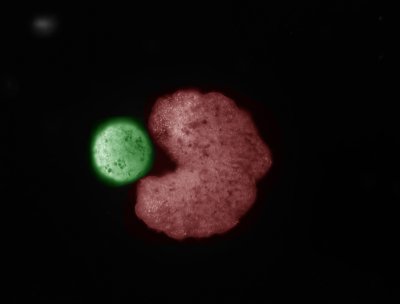I have always been very interested in building objects and creating robots, but who isn't? Robots are the coolest. I've always thought they were great and wanted to work on them, but it took me a while to get to robotics.
I was very interested in the arts early on and in high school I was more focused on computer graphics and photography. But when I went to college I began to wonder how good at art I really was and whether it was perhaps more of a hobby, so I fell back on math. I then worked for three years as a data scientist for an insurance company. That is not exciting; there are no robots there!
At 25, I went back to school and studied computer science and robotics. It was what I had always wanted to do but it took me a while to realize that I could do it. It seems kind of daunting, like you must have to be a child prodigy at coding. That's not true—at least I hope it's not!
What is a robot?
I built my first robot in graduate school, when I was in my late 20s. It was a soft robot made from rubber, which was something I was interested in during my PhD studies.
What makes a robot different from your laptop computer is that robots move themselves through the world like animals. Just like animals, robots can come in all matter of shapes and sizes, depending on what they are designed to do and what materials they are made of.
One of the characteristics of animals is that they are created from soft materials, but we normally build robots out of metal or plastics. Unfortunately, those aren't so great because eventually they break and become trash and pollution. I began to think about how we could make robots out of a material that is biodegradable and biocompatible. Perhaps it is naive, but a solution seems to be to build robots out of the same things animals are built out of, which is cells.
My colleagues and I at the Wyss Institute for Biologically Inspired Engineering at Harvard University began thinking that there could be a lot of advantages to soft robots; perhaps they could interact better with humans and be safer? Or, maybe they could be more intelligent or perform certain tasks better because they could use soft materials like animals do? But soft robots can be difficult to design so we use AI and computers to help understand what they should look like.
Normally you have an objective for a robot: you want it to walk or clean your floor, for example. Then comes the questions of what to make it from, what it will look like and how it is going to perform the task. "What should my robot look like?" is a question that most of my work has been trying to address.
The genesis of the Xenobots
Building robots out of cells really arose spontaneously out of a collaboration. I knew we had Xenopus Laevis frogs in our biologist collaborator, Doug Blackiston's lab at University of Vermont, Tufts University. These eggs are used for all kinds of important developmental biology, and in 2018, Doug bet me we could build robots out of them, so I dove into it full time.
The two simplest to use were skin cells and heart muscle cells and the ethics behind it are really sound. You take one day old frog eggs but there's nothing in that egg, there aren't neurons in there and it can't feel pain. A lot of times they are thrown away before they develop into anything. Doug developed all the biology methods to build robots out of cells, which are simple enough that I can follow them without previous biology training, and we then asked how we could get this robot to do what we wanted it to do.
That's where an AI comes into this, it's like a collaborator and design tool. It offers up all these different ways to put these cells together to create a robot that does what you want; walking, for example. It's very much like using Lego blocks, but the Legos are cells and tissues.
The computer puts the cells together in random ways and determines which of these configurations does more or less of what we want the robot to do. As you can imagine, a random conglomeration of cells is probably not going to do what you want. Some won't move at all, but some might fall down, which is a little closer to walking or moving along. The computer takes those good designs, modifies them and deletes the bad designs.
Once we showed that we could design living robots—which we have called Xenobots—to behave in specific ways, we were then able to observe that they can do all these amazing things that it's not so easy for regular robots to do.
Discovering that Xenobots self-reproduce and self-heal
The Xenobots can self-heal, which is amazing from a robotics standpoint—though maybe not so surprising to a biologist, because we all self heal. You can cut this robot almost in half and it just zippers up and starts moving as it was before. No other robot can do that. Some of these behaviors that seem obvious to biologists become really amazing ideas and perspectives to roboticists.


But the way the Xenobots reproduce was surprising to both roboticists and biologists. Every single organism on the planet that we know of, reproduces either sexually or asexually. Reproduction involves parents or a parent organism giving part of itself, and from that small part, or parts, a baby or offspring grows.
We saw there was something really amazing that Xenobots could do. If we sprinkle loose stem cells in their dish Xenobots will move around in the dish, pushing those cells together into piles that develop into more Xenobots. They are able to reproduce in an entirely different way—this was more like Xenobots building other Xenobots.
When we gave their children more cells to build with, they sometimes produced grandchildren. But then reproduction stopped. So, we wanted to see if it could last longer.
We asked our computer what we could do to amplify the reproduction and make it last longer, and the most successful alteration was changing the shape of the parent Xenobots. You can carve them into any shape you want, even a little dog! But after weeks of trying different shapes, it gave us a very simple design that looks like Pac-Man. This Xenobot has a "mouth" carved out and moves around, and because of that, it traps cells in there and is better at being a snowplow; pushing cells into larger piles. These larger piles are more likely to develop into offspring and this process of self-replication lasts longer.

In 2020, we had discovered we could build robots out of cells and started to see early evidence of this self-replication. But it took a while to make sure it wasn't just chance and to prove that Xenobots really were really building other Xenobots, so we didn't release our findings until the end of 2021.
It's much simpler than most people realize, and it's probably important to emphasize that. A Xenobot is not the most complicated and useful robot, there's a lot it cannot do and there are lots of conditions that have to be perfect. However, roboticists all recognize that this is a robot and a kind of self-reproduction. It's not a robot dancing on the internet or doing construction outside, it's very limited, but our description is accurate.
Will living robots take over the world?
People ask if the Xenobots are going to take over the world? We are very confident that this technology is safe because they can't reproduce unless they're in a petri dish and we keep giving them more cells to build with. Even if we do that, the self-replication stops after about five rounds. And even that took months; it was a lot of effort and there are still humans in the loop. It's also extremely safe because it's just frog skin cells. Frogs shed their skin all the time in lakes and streams and we don't really care about that. This is contained within a lab and there are very strict policies here. But, I think it's healthy for people to be skeptical of this kind of science and about technologies getting out of control. I also understand there is something about it that might bother people; it's a robot made of frog skin. But I think if you dig a little deeper, you can see how simple it is and how much potential good it can do.
We've only been building robots made entirely out of living cells for three years now, but in many ways they are already much better than robots we've been making since the 1940s. These are self-healing, biodegrading and self-replicating robots.
Right now, Xenobots have to be in an aquatic environment. So, if they're going to be useful robots they will probably have underwater applications. Maybe they will end up cleaning up lakes, streams and oceans, because there are many small contaminants in waterways that are difficult to see. We know the Xenobots are very good at making piles, and they are also self powered. They come pre-loaded with fat and protein that they burn. They live off that energy for about two weeks and then they biodegrade.


Science isn't easy, most experiments do not work out as expected. You fail 100 times in a row, then the 101st experiment goes really well and the world may take notice, which happens sometimes and that's amazing. It's really rewarding. At first it's overwhelming, but of course I'm very thankful for all this support and interest. A lot of science research goes without any recognition, which is sad.
My hope is that this is exciting for people. In particular, we've seen young people getting extremely excited about Xenobots. I get dozens of emails every month from students aged from middle school through to undergraduate and I'm very passionate about getting the next generation involved in this work. We have been creating soft robot kits for the classroom and more recently we've been trying to do the same with the Xenobots. We hope to make a really simple kit so that many people can see first hand that this is not something to be worried about because they built one in their biology class.
There's a lot you can learn from this, and who knows what the next generation will do with it. Probably way more than I can imagine now.
Sam Kriegman PhD is a computer scientist with a joint postdoctoral appointment at the Wyss Institute at Harvard and the Allen Discovery Center at Tufts. His work on Xenobots has been developed with senior scientist Doug Blackiston PhD. You can follow Sam on Twitter @Kriegmerica.
All views expressed in this article are the author's own.
As told to Jenny Haward.
Uncommon Knowledge
Newsweek is committed to challenging conventional wisdom and finding connections in the search for common ground.
Newsweek is committed to challenging conventional wisdom and finding connections in the search for common ground.





